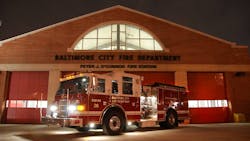Grappling with a significant rise in emergency medical calls, the Baltimore Fire Department plans to reduce the number of engines, trucks and battalion chiefs it dispatches to initial fire alarms beginning on Sept. 1, according to a department memo dated Wednesday.
Three engines, one truck and one battalion chief will be dispatched to an alarm, down from the five engines, two trucks, two battalion chiefs and one medic unit that constitutes a full box alarm assignment, according to the memo.
“Local Alarm will reduce the number of units dispatched to box alarms,” the memo says. “Multiple 911 calls to Fire Communications would warrant the full Box Alarm Assignment.”
Baltimore Fire Chief Niles R. Ford said the initial response reduction will “make sure we have [fire] suppression units available for other calls, in particular, EMS calls,” while providing battalion chiefs the discretion to escalate fire responses as needed.
Firefighters are cross-trained as emergency medical service units and can respond to ambulance calls, he said.
“Our goal, at end of the day, is to make sure we leverage the resources we have to respond to the level and type of calls we have,” Ford said in an interview.
The International Association of Firefighters Local 734, which represents unionized rank-and-file Baltimore firefighters, criticized the planned response reduction.
“This local is against any changes that will lower the amount of units on [an] initial response,” the union tweeted Thursday. “This not only puts our members in danger but the citizens of Baltimore.”
Local 734 president Richard “Dickie” Altieri II could not immediately be reached for comment Thursday.
The fire chief said he disagreed with the union’s criticism, arguing that shifting department resources is “not earth-shattering” and has been done “since the beginning of time.”
The number of personnel dispatched to initial fire alarms after Sept. 1 will still exceed the National Fire Protection Association’s recommendations, Ford said. Seventeen fire department personnel will respond to an initial call, higher than the standard of 15 set by the NFPA, he said.
The department has increased the number of ambulances in the field in Baltimore by 50 percent in the past five years to deal with a deluge of drug overdoses and other emergency medical calls, the chief said. The union has criticized the department for using firefighters to staff medic units, saying it leads to longer fire response times. The department has responded that it is working to address staffing shortages.
“We’re still struggling to keep up," Ford said. “The ultimate goal is to make sure we have the availability of resources for the call volume that has increased."
He could not immediately provide numbers to document the increase in medical calls.
The potent synthetic opiod drug fentanyl was the dominant drug causing overdose deaths in Maryland in the first three months of 2019, although the total number of deaths dropped 8% from the same period in 2018.
Fatal overdoses of Fentanyl have continued to increase in about half of Maryland’s counties and Baltimore City, where 215 people died in January, February and March — four more than a year ago.
Baltimore Sun reporter Meredith Cohn contributed to this article.
———
©2019 The Baltimore Sun
Visit The Baltimore Sun at www.baltimoresun.com
Distributed by Tribune Content Agency, LLC.






